Music is the universal language
“Glory to God in the highest heaven, and on earth peace to those on whom his favor rests.” - Luke 2:14
Norse Guitar Feeds
Tubesteader Releases Gainlord Preamp/Overdrive
Tubesteader releases the Gainlord™, a dual-channel preamp/overdrive inspired by British amps from the late ’60s through the ’80s, the amps that defined hard rock.
Built on real high-voltage tube circuitry, it delivers the same punch, harmonic richness, and touch-sensitive response as the original amps — all in a compact pedal format.
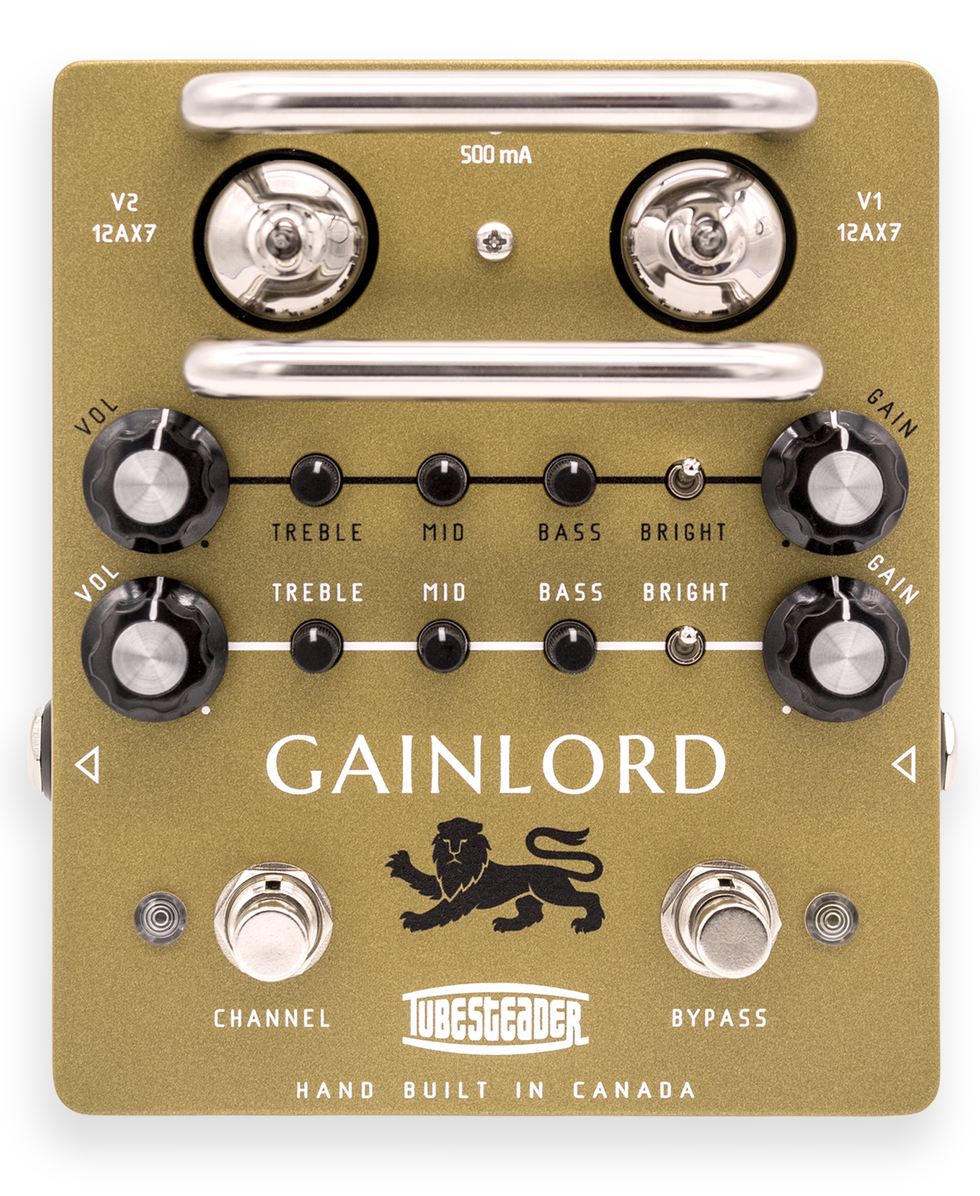
The low-gain channel is open and gritty, breaking up around 9 o’clock. Push it harder, and it develops a grainy crunch with sagging lows that add warmth and body. The high-gain channel is tighter and more aggressive, with defined notes and extra top-end bite, yet cleans up naturally when the guitar’s volume is rolled back. Both channels include a Bright switch for added presence; on the high-gain channel, it can also provide a subtle gain boost. A 3.5mm TRS jack allows remote control of channel switching and the high-gain Bright switch. The Tone Cut switch offers two modes: a full-output preamp for power amps or cab simulators, or a lower-level overdrive mode with scooped high-mids for front-of-amp use. Power is supplied via the included AC/DC adapter or any 12V DC, 500mA pedalboard supply.
The Gainlord can be used in front of an amp, into a power amp, or directly with a cab simulator. It comes with a wall-mount power supply and a country-specific plug. The Gainlord street price is $349 USD. Available at select retailers or directly from the Tubesteader online store www.tubesteader.com.
Strymon Introduces New Olivera Vintage Oil Can Echo
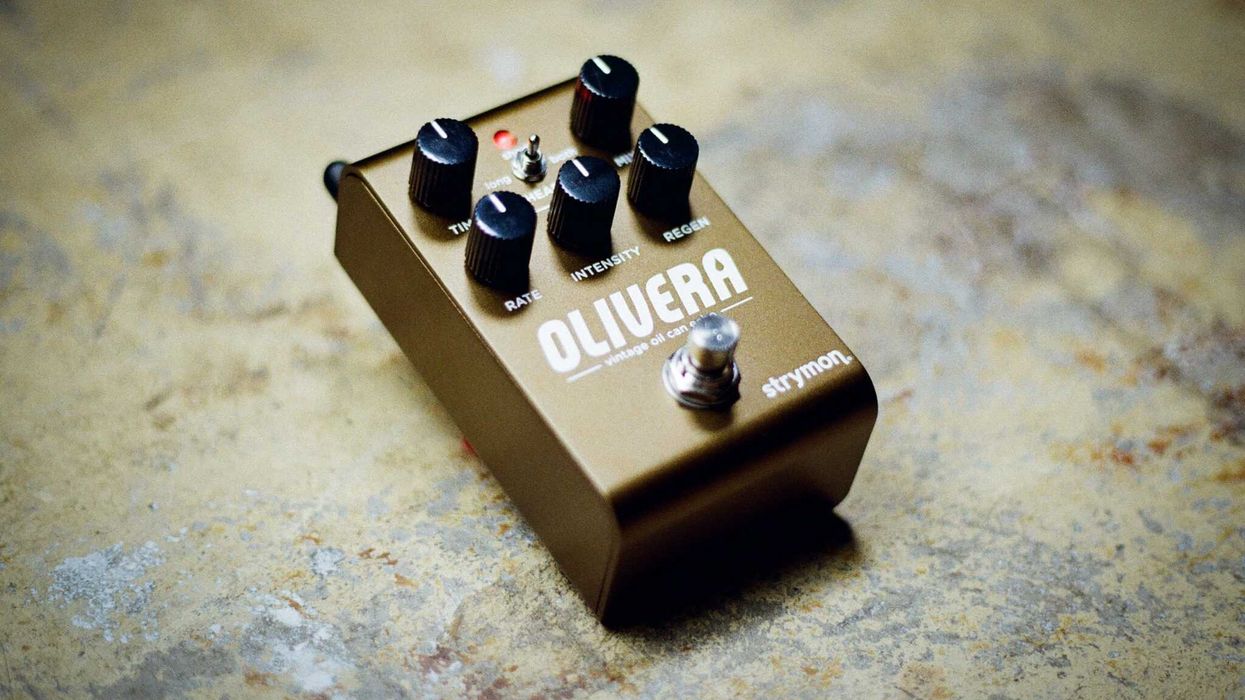
Strymon Engineering (www.strymon.net), theLos Angeles-based manufacturer of premium guitar, plugin and Eurorack products, todayannounced the arrival of their newest compact effects pedal, named Olivera. Based uponextensive research into what truly makes vintage oil can echo units tick, Olivera represents themost accurate reproduction of these devices ever offered in a compact form factor.
Oil can echoes like the classic Tel Rey® units actually used a motorized rotating can andlubricating oil to generate the murky repeats that they’re known for, creating a mountain oforganic variables that make recreating their behavior in software a major challenge. The resultof all of this research is a brand-new algorithm that has never before appeared in a Strymonproduct, capable of generating all of the organic chaos and vibe of the original units.All of the vintage flavor also comes with modern features like independent stereo processing of
the left and right inputs, full MIDI and expression control, stereo TRS ins and outs with multipleaudio routing modes and USB-C for firmware updates and computer control.
“This was a fun project to dig into and get right”, said Pete Celi, Strymon co-founder and DSPguru. “The sheer number of organic variations and interactions makes recreating the behaviorof a device like this pretty daunting, but that makes it even more rewarding when it all comestogether.”Celi continues, “I imagine that many folks would say that these units are simply filtered anddark, but it goes way beyond that. The way that these systems record and play back the signalresults in a really unique and magical ambience that doesn’t sound like anything else.”Olivera is available now directly from Strymon and from dealers worldwide for $259 US.For additional information visit https://www.strymon.net.
Fender Expands American Professional Series
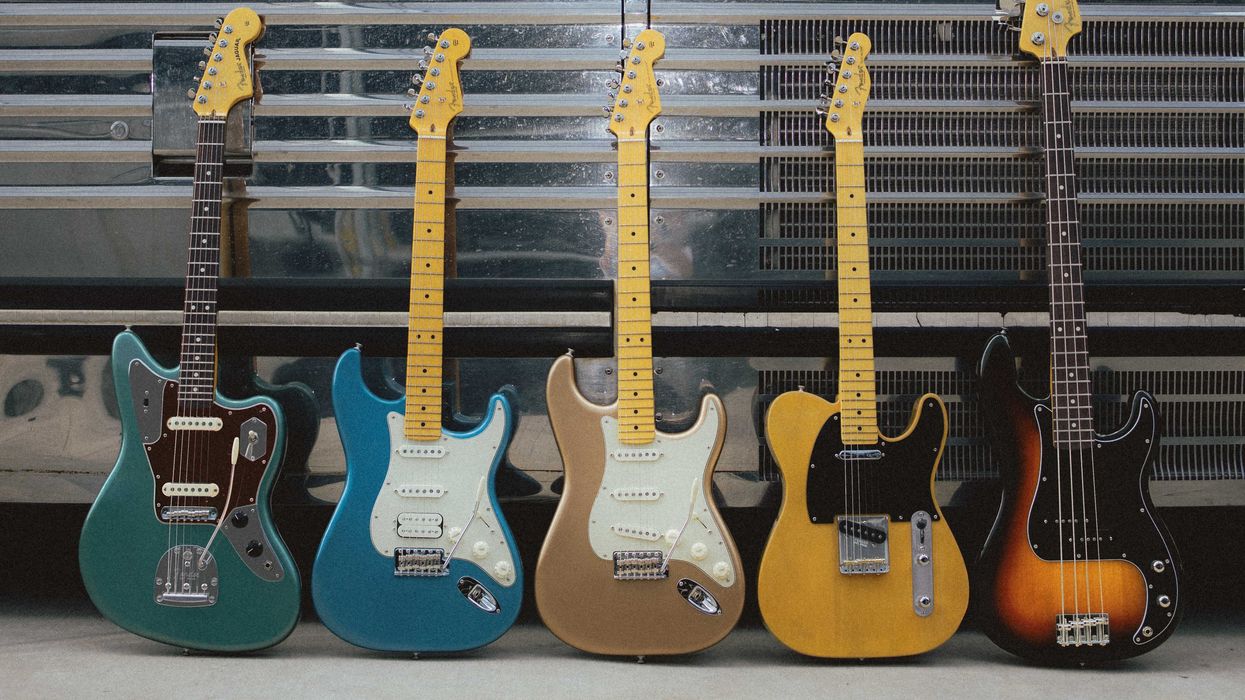
Fender Musical Instruments Corporation (FMIC) today announces the launch of the American Professional Classic, the newest evolution in Fender’s modern classic American Professional series and the embodiment of the brand’s legacy as the definitive leader in electric guitars. “Tested. Trusted. Night After Night.” this series is built for players who demand reliability, versatility and performance at the highest level. From first gigs in garages to global festival stages, across every genre and generation, the American Professional Classic delivers timeless Fender tone, precision craftsmanship and modern refinements that make it a trusted instrument for musicians everywhere.
Rooted in Fender’s heritage of American innovation, the American Professional Classic combines durability, adaptability and uncompromising playability. Its enhanced neck profile, all-new Coastline pickups, and upgraded hardware make it as comfortable to play in the studio as it is on tour, while classic finishes and bold color options ensure it looks as good as it sounds. Whether for seasoned professionals, emerging artists, or players exploring new sounds, this guitar is engineered to support creative expression, inspire performance and deliver consistency on every stage.
“The American Professional Classic is all about delivering a great playing experience,” said Max Gutnik, Chief Product Officer at FMIC. “We focused on every detail: from the all-new Coastline pickups, which offer clear, punchy tone across every register, to the Modern-‘C’ neck with rolled fingerboard edges that feels comfortably broken-in from day one. We combined vintage-inspired finishes and hardware with thoughtful upgrades like staggered ClassicGear™ tuners, Mustang saddles on the offsets, and slotted Telecaster barrel saddles. The result is a guitar that’s easy to play, sounds incredible and adapts to any style or stage.”
Music today is experiencing a powerful guitar-driven resurgence, with a new generation of artists bringing raw, garage-band energy onto the world’s biggest stages. Turnstile is one of the bands leading the charge, packing arenas with their genre-blurring sound and DIY ethos, while emerging musicians like Fleshwater and Horsegirl, who are both part of the Fender Next roster, embody that same spirit of rawness and edge. At the same time, fellow Fender Next artists Balu Brigada and DARUMAS showcase the artistic highs that define Pop Music in 2025 - trading riffs, building songs together, and sharing the joy of collective creativity. Across genres and styles, these artists and their fans are fueling a cultural moment where the guitar is further cemented as the heartbeat of live music.
The American Pro Classic was built for this moment, offering the sonic versatility to meet the demands of today’s artists, with its fearless spirit embodied by Turnstile, the Baltimore hardcore band fronting the campaign. Known for their explosive live shows and genre-defying sound, Turnstile showcases how the guitar empowers musicians to create boldly and connect deeply with fans. Yet the American Pro Classic’s appeal extends far beyond one band or one genre; it reinforces Fender’s role as a unifying force in music, delivering inspiration for artists everywhere.
“When you're in a different place constantly, sometimes the most familiar thing is the guitar that you bring every single night,” said Pat McCrory from Turnstile. “We look for something that sounds the same every time, sounds exactly how you want it, but also has versatility because spaces change. Sometimes you play outside, sometimes it sounds different, sometimes you play inside or there's noise lighting. Having some durability but flexibility is very important.”
Key upgrades include:
- All-New Coastline Pickups – slightly overwound Pure Vintage recipes and are engineered for clarity, punch, and dynamic expression, delivering Fender’s signature warmth and bite across every register, from subtle nuances to soaring leads.
- Enhanced Neck Profile – a comfortable Modern-‘C’ shape with rolled fingerboard edges designed for speed, fluidity, and long-playing comfort, adapting seamlessly to any style or technique.
- Upgraded Hardware & Tuning Stability – premium components including upgraded vintage bridges and precision ClassicGear™ tuning machines, ensure rock-solid tuning on stage and studio reliability for recording sessions.
- Classic Finishes in Bold Colors – a curated selection of timeless Fender finishes reimagined for modern players, combining iconic aesthetic appeal with fresh, vibrant options for the next generation of guitarists.
American Professional Classic Stratocaster

($1,499.99 USD, £1,499 GBP, €1,799 EUR, $2,599 AUD, ¥242,000 JPY)
The perfect blend of vintage charm and modern performance – the American Professional Classic Stratocaster®. Under the hood, vintage-inspired Coastline™ ’57 Stratocaster® pickups deliver depth, punch and sparkle while the sleek Modern “C” neck provides exceptional comfort and playability. Fender Staggered ClassicGear™ tuners provide classic looks and precise tuning stability. Boasting custom-faded vintage and signature Fender® finishes, this professional-grade instrument looks as good as it sounds. From studio to stage, The American Professional Classic Stratocaster® All the soul of a golden-era Fender®, evolved for today’s player. Options include Rosewood Fingerboard in Faded Black, Faded Dakota Red, Faded Sherwood Green Metallic as well as Maple Fingerboard in Faded Firemist Gold, Faded Lake Placid Blue and 3-Color Sunburst.
American Professional Classic Stratocaster HSS

($1,549.99 USD, £1,549 GBP, €1,849.00 EUR, $2,699 AUD, ¥264,000 JPY)
The perfect blend of vintage charm and modern performance – the American Professional Classic Stratocaster® HSS. Under the hood, vintage-inspired Coastline™ ‘57 Stratocaster® pickups and Coastline™ humbucker deliver depth, punch and sparkle while the sleek Modern “C” neck provides exceptional comfort and playability. Fender Staggered ClassicGear™ tuners provide classic looks and precise tuning stability. Boasting custom-faded vintage and signature Fender® finishes, this professional-grade instrument looks as good as it sounds. From studio to stage, The American Professional Classic Stratocaster® HSS All the soul of a golden-era Fender®, evolved for today’s player.Options include Rosewood Fingerboard in Faded Sherwood Green Metallic as well as Maple Fingerboard in Faded Lake Placid Blue, Faded Black and 3-Color Sunburst.
American Professional Classic Telecaster

($1,499.99 USD, £1,499 GBP, €1,799 EUR, $2,599 AUD, ¥242,000 JPY)
The perfect blend of vintage charm and modern performance – the American Professional Classic Telecaster®. Under the hood, vintage-inspired Coastline™ ’63 Telecaster® pickups deliver depth, punch and sparkle while the sleek Modern “C” neck provides exceptional comfort and playability. Fender Staggered ClassicGear™ tuners provide classic looks and precise tuning stability. Boasting custom-faded vintage and signature Fender® finishes, this professional-grade instrument looks as good as it sounds. From studio to stage, The American Professional Classic Telecaster® All the soul of a golden-era Fender®, evolved for today’s player. Options include Rosewood Fingerboard 3-Color Sunburst, Faded Black, and Faded Dakota Red as well as Maple Fingerboard in Butterscotch Blonde,Faded Sherwood Green Metallic and Faded Lake Placid Blue.
American Professional Classic Hotshot Telecaster

($1,549.99 USD, £1,549 GBP, €1,849 EUR, $2,699 AUD, ¥264,000 JPY)
The perfect blend of vintage charm and modern performance – the American Professional Classic HotShot™ Telecaster®. Under the hood, vintage-inspired Coastline™ ’63 Telecaster® and ‘57 Stratocaster® pickups deliver depth, punch and sparkle while the sleek Modern “C” neck provides exceptional comfort and playability. Fender Staggered ClassicGear™ tuners provide classic looks and precise tuning stability. Boasting custom-faded vintage and signature Fender® finishes, this professional- grade instrument looks as good as it sounds. From studio to stage, The American Professional Classic Hotshot Telecaster® All the soul of a golden-era Fender®, evolved for today’s player. Options include Rosewood Fingerboard in Butterscotch Blonde and Faded Sherwood Green Metallic as well as Maple Fingerboard in 3-Color Sunburst and Faded Lake Placid Blue.
American Professional Classic Jazzmaster

($1,599.99 USD, £1,599 GBP, €1,899 EUR, $2,799 AUD, ¥264,000 JPY)
The perfect blend of vintage charm and modern performance – the American Professional Classic Jazzmaster®. Under the hood, vintage-inspired Coastline™ ’65 Jazzmaster® pickups deliver depth, punch and sparkle while the sleek Modern “C” neck provides exceptional comfort and playability. Fender Staggered ClassicGear™ tuners deliver classic looks and precise tuning stability. Boasting custom-faded vintage and signature Fender® finishes, this professional-grade instrument looks as good as it sounds. From studio to stage, The American Professional Classic Jazzmaster® All the soul of a golden-era Fender®, evolved for today’s player. Options include Rosewood Fingerboard in 3-Color Sunburst, Faded Firemist Gold, Faded Sherwood Green Metallic and Faded Dakota Red.
American Professional Classic Jaguar
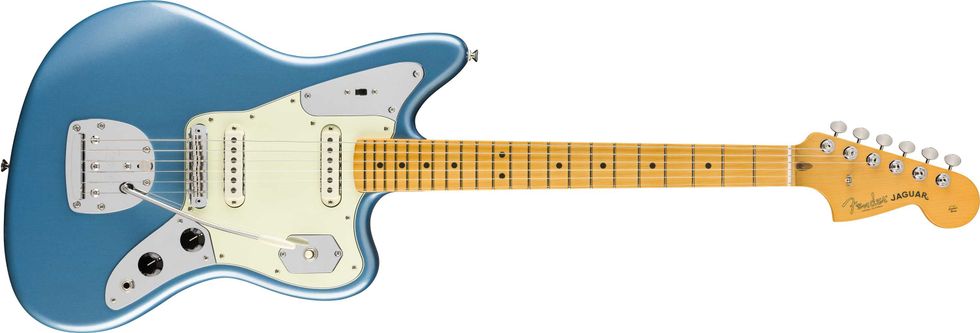
($1,599.99 USD, £X GBP, €1,899 EUR, $2,799 AUD, ¥264,000 JPY)
The perfect blend of vintage charm and modern performance – the American Professional Classic Jaguar®. Under the hood, vintage-inspired Coastline™ ’65 Jaguar® pickups deliver depth, punch and sparkle while the sleek Modern “C” neck provides exceptional comfort and playability. Fender Staggered ClassicGear™ tuners deliver classic looks and precise tuning stability. Boasting custom-faded vintage and signature Fender® finishes, this professional-grade instrument looks as good as it sounds. From studio to stage, The American Professional Classic Jaguar® All the soul of a golden-era Fender®, evolved for today’s player. Options include Rosewood Fingerboard 3-Color Sunburst, Faded Sherwood Green Metallic and Faded Firemist Gold as well as Maple Fingerboard in Faded Lake Placid Blue.
American Professional Classic Precision Bass

($1,599.99 USD, £1,549 GBP, €1,849 EUR, $2,799 AUD, ¥264,000 JPY)
The perfect blend of vintage charm and modern performance – the American Professional Classic Precision Bass®. Under the hood, the vintage-inspired Coastline™ ’60 split-coil Precision Bass® pickup delivers depth, punch and articulation while the sleek Modern “C” neck provides exceptional comfort and playability. Fender ‘lollipop’ tuners deliver classic looks and precise tuning stability. Boasting custom-faded vintage and signature Fender® finishes, this professional-grade instrument looks as good as it sounds. From studio to stage, The American Professional Classic Precision Bass® All the soul of a golden-era Fender®, evolved for today’s player. Options include Rosewood Fingerboard in Faded Sherwood Green Metallic and 3-Color Sunburst as well as Maple Fingerboard in Faded Lake Placid Blue.
American Professional Classic Jazz Bass

($1,599.99 USD, £1,549 GBP, €1,849 EUR, $2,799 AUD, ¥264,000 JPY)
The perfect blend of vintage charm and modern performance – the American Professional Classic Jazz Bass®. Under the hood, vintage-inspired Coastline™ ’62 Jazz Bass® pickups deliver depth, punch and articulation while the sleek Modern “C” neck provides exceptional comfort and playability. Fender ‘lollipop’ tuners deliver classic looks and precise tuning stability. Boasting custom-faded vintage and signature Fender® finishes, this professional-grade instrument looks as good as it sounds. From studio to stage, The American Professional Classic Jazz Bass® All the soul of a golden-era Fender®, evolved for today’s player. Options include Rosewood Fingerboard in Faded Firemist Gold and 3-Color Sunburst as well as Maple Fingerboard in Faded Dakota Red.
American Professional Classic Mustang Bass

($1,599.99 USD, £1,499 GBP, €1,799 EUR, $2,799 AUD, ¥264,000 JPY)
The perfect blend of vintage charm and modern performance – the American Professional Classic Mustang® Bass. Under the hood, the vintage-inspired Coastline™ ‘70 Mustang® Bass split-coil pickup delivers depth, punch and articulation while the sleek Modern “C” neck provides exceptional comfort and playability. Fender ‘lollipop’ tuners deliver classic looks and precise tuning stability. Boasting custom-faded vintage and signature Fender® finishes, this professional-grade instrument looks as good as it sounds. From studio to stage, The American Professional Classic Mustang® Bass All the soul of a golden-era Fender®, evolved for today’s player. Options include Rosewood Fingerboard, 3-Color Sunburst and Faded Sherwood Green Metallic as well as Maple Fingerboard in Faded Dakota Red.
Stompboxtober 2025: PRS

Bring clarity and grit together! Enter today’s #Stompboxtober giveaway for your chance to WIN the PRS Horsemeat transparent overdrive — add harmonic midrange richness and overdrive without losing your highs. Dial it as a clean boost or up the gain — it’s all about preserving your tone. Come back tomorrow for another pedal shot!
Stompboxtober 2025 - Win Pedals All Month Long!
PRS Horsemeat
The PRS Horsemeat transparent overdrive pedal is designed to enhance your sound without coloring your tone. Horsemeat adds harmonic midrange richness and overdrives without cutting out your high notes – all while giving you more available headroom. It features a robust EQ section so you can dial in your tone and has a wide range of gain on tap. Depending on the setting, Horsemeat can be used as a clean boost, straight overdrive, or even enhance your amplifier’s distortion by slightly pushing the front end of the amplifier’s preamp section.
PRS pedals were created to be high-end pieces of audio gear.

PRS Horsemeat Transparent Overdrive Pedal
R&B legend and neo-soul pioneer D’Angelo dies at 51

Grammy-winning R&B legend D’Angelo – one of the pioneers of neo-soul – has died aged 51 following a battle with pancreatic cancer.
In a statement shared with Variety, his family confirmed the singer and guitarist – real name Michael Eugene Archer – died on Tuesday morning (14 October) at his home in New York.
“The shining star of our family has dimmed his light for us in this life… After a prolonged and courageous battle with cancer, we are heartbroken to announce that Michael D’Angelo Archer, known to his fans around the world as D’Angelo, has been called home, departing this life today, October 14th, 2025,” the statement reads.
“We are saddened that he can only leave dear memories with his family, but we are eternally grateful for the legacy of extraordinarily moving music he leaves behind. We ask that you respect our privacy during this difficult time but invite you all to join us in mourning his passing while also celebrating the gift of song that he has left for the world.”
Releasing three albums over the course of his career, D’Angelo was a pioneer of the neo-soul R&B subgenre, which blends classic soul with influences from the likes of jazz and hip-hop, often flavouring R&B with more live instrumentation.
Releasing Brown Sugar and Voodoo in 1995 and 2000, respectively, D’Angelo subsequently spent over a decade out of the public eye, before returning with the critically acclaimed Black Messiah in 2014, which featured hits like Really Love and Sugah Daddy.
D’Angelo earned Best R&B Album Grammy wins for both Voodoo and Black Messiah.
Born in Richmond, Virginia, 1974, the son of a Pentecostal minister, D’Angelo taught himself to play piano aged only three. Through his adolescent years, he performed in groups locally, and won an amateur talent competition at Harlem’s Apollo Theater for three consecutive weeks, drawing the attention of EMI executives, who quickly signed him to a publishing deal.
His debut album Brown Sugar was a commercial and critical success, and helped him go on to collaborate with legends including Jay-Z, Snoop Dogg and Q-Tip.
After over a decade out of the public eye after 2000’s Voodoo, D’Angelo returned to music in 2014 with Black Messiah, an album in the works for years, but finished after witnessing the national unrest spurred by protests over the deaths of unarmed Black men Michael Brown and Eric Garner.
This is a developing story.
The post R&B legend and neo-soul pioneer D’Angelo dies at 51 appeared first on Guitar.com | All Things Guitar.
Strings, Sweat, and Survival: An Insider Look at the World of a Guitar Tech

The life of a guitar tech is equal parts craft, chaos, and on-the-fly problem-solving. Though Ryan Chan, Luis Munoz, and Drew Foppe share this whirlwind existence, their unique paths—and the gigs those paths have led to—highlight just how varied and demanding it can be.

Chan’s journey began long before he was wrangling digital and hybrid rigs for bands like Loathe and Spiritbox. Growing up in Hong Kong, he dreamed of music production, though a move to the U.K. would quickly alter that goal. Munoz took a more deliberate path, landing in Hollywood and sharpening his skills as a luthier before finding himself in the middle of pop-rock’s great revival working for Olivia Rodrigo. Foppe, meanwhile, initially had no desire to work in music, but he still found himself pulled into a decades-long career with some of the biggest names in the business.
These three techs come from very different places, both professionally and geographically. Still, their stories converge in the relentless grind of touring life, full of long days, constant travel, and endless hours working behind the curtain to keep internationally-known guitarists playing and sounding their best. Here, they step out from behind that curtain to discuss the stories, rigs, and realities that shape a life lived just out of the spotlight.
Ryan Chan (Loathe, Spiritbox)
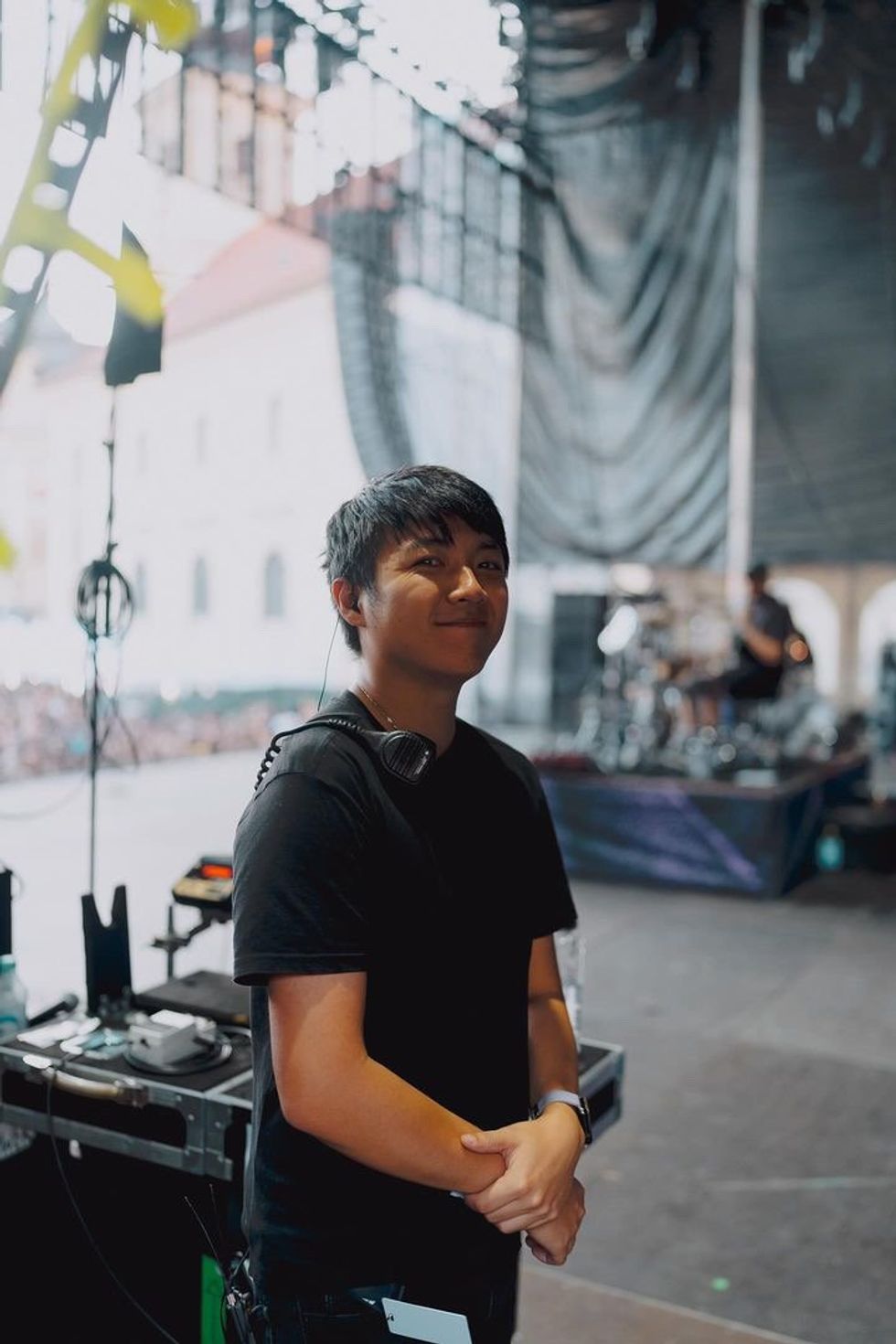
You were born in Hong Kong and literally moved halfway across the world to start your career. Tell me about that journey and how you became a guitar tech.
Ryan Chan: I wanted to be a producer, so I came to Leeds six years ago because of music university, where I joined the music production program. There was one guy in my course named Adam, who’s a good friend of mine, and he was a front-of-house engineer for Loathe. I think at one point they needed a tech, and he was like, “You like to mess with guitars. Come do it with me on the road.” And that’s how it all started.
You’re currently working with Loathe and planning a big North American tour. What’s a day in the life for you when you’re out with them?
Chan: We don’t load in until maybe 2 o’clock. From there, it’s just kind of getting everything set up. I get all the pedalboards laid out and everything else ready to be thrown on the stage. Then it’s soundcheck, show, and then pack down, and on to the next show. I usually restring the guitars maybe once every three to four days.
As of this next tour, they’re also having me more involved outside of just the touring stuff. Like, two days ago, I was at Loathe’s new space helping program some sets with the playback and MIDI stuff.
Loathe showcased some of their unique guitars and equipment on one of our Rig Rundowns. What are they taking out these days?
Chan: There are four guitars and four basses. Some of them are spares that get used depending on how they’re feeling that day. We don’t carry different guitars with different tunings. They use multiple tunings, but they’ll tune everything themselves. The main variation is, one’s a baritone and one’s a normal-scale guitar. And I’m the only backline tech, so I’m also the one who looks after all their MIDI keyboards and stuff, too.
Loathe still use tube amps, although a lot of bands have turned to digital modelers for touring. How has the rise in digital touring rigs affected your work?
Chan: I’m used to it. Digital’s reliable, and it’s predictable. You’re not rolling the dice every time you put the amp in the trailer. When I worked with Spiritbox, they’ve always been all digital.
But with Loathe, it’s actually an interesting hybrid of [Fractal] Axe-Fx and amps. Eric [Bickerstaffe] plays with a [Marshall] JCM800 and treats the Axe-Fx as a big front-end pedalboard. Faisal [El-Khazragi], the bass player, uses an Ampeg SVT. But I believe, for this next tour, we’re actually switching back to Axe-Fx for pure simplicity. I guess, maybe more so for bass, the trade-off is worth it.
You’re still in the early part of your career. Are there any lessons you’ve learned on the road that make you better at your job?
Chan: One thing I’ve had to learn is how to communicate and ask people for help, rather than waiting for someone higher up to do the asking for me. You’ve gotta be a bit more assertive, and be like, “All right, here’s an issue. I need to go find the people that will help me fix this issue.” Also, if I’m gonna say no to something, I’d better have a really good reason as to why we can’t do it.
Talk about the reality vs. the expectation of being a touring guitar tech.
Chan: I don’t want to undersell it, but it’s not as glamorous as people might want to make it out to be. It is very much a job. When you first get into it, it’s so fresh, and it’s so exciting. It’s so fun. Then suddenly that wears off, and you have to look at it as a responsibility. So learning to enjoy the road again has been a fun experience for me.
The three tools Ryan Chan can’t live without:
● Dunlop String Action Gauge
● Multi-bit screwdriver
● USB-powered soldering ironLuis Munoz (Olivia Rodrigo, Smashing Pumpkins, Bush, LP)

Your goal was always to be a guitar tech. But how did you get your foot in the door in such a competitive industry?
Luis Munoz: It’s a hard community to get into, but once you’re in, you’re in forever. So I remember thinking to myself, “I’m going to become undeniable and really good at what I do.” So, I went to Guitar Craft Academy in Hollywood and started working in shops around town. But I always wanted to go on tour. Then one of my clients and another buddy got me a gig, and I went on my first tour for an artist that goes by the name of LP. Just like that, I started getting call after call.
You’ve worked for some massive rock bands. But working in a huge pop production like Olivia Rodrigo’s has to be a lot different. What’s a typical day in that camp look like?
Munoz: My days would start with changing strings and doing all the stuff that I need to so that, when the stage is rolled into place, we can start plugging in, patching, and making sure everything works. We do a quick line check, and then the band would come out and run a song or two. Then you hurry up and wait until it’s your time to do a show.
Doing the show is, I feel, what’s different in the pop world versus the rock world. I was part of the show. I would hand [Olivia] the guitar way out at the end of the thrust. Then I’d have to run that whole thing back, and, when she’s literally about to hit the chord, I would hit the unmute button. Then, when she’s done, I’d mute it, go on stage, and she’d throw me the guitar. After every show, I’d be drenched in sweat, like I just worked out.
Olivia is featuring a ton of guitar in her shows these days, and you’re responsible for three players, including your wife, bassist Moa Munoz. What kind of gear does the production require?
Munoz: Olivia loves rock and wants to try different things. So, this last tour we went from having two guitars to seven. It’s another funny pop-world thing, but we had different guitars for different outfits.
And yeah, I would also take care of my wife, Moa, who had five basses, and Daisy [Spencer], the second guitar player. She was doing a lot of acoustic stuff, but said, “I want to play electric on this tour.” I thought the [Ernie Ball Music Man] St. Vincent might look cool, and she was like, “Fuck yes. That’s the one!”
Ariana [Powell, guitar] also had a whole guitar boat to herself. My buddy takes care of her on stage right.
With such a choreographed production, are you guys using digital amp modelers?
Munoz: Definitely, I don’t think people understand how many variables you have to deal with when using amps. Everything from if the power is different to amps going from a trailer to a sea container to a plane to a bus. So Daisy and Ari were on Kempers, and then Moa was on Helixes. It’s all MIDI-controlled, because even the band actually has choreography now.
Tell me about a humbling experience or a lesson you learned on the road that made you better at what you do.
Munoz: When I was still doing local repairs and things, [Bush guitarist] Chris Traynor’s tour manager called me and asked, “Have you ever been on tour as a tech?” And I was like, “You know what? No. But I can’t imagine it being hard.” I remember he was like, “Did you just say it was going to be easy? I don’t think this is gonna work out.” [Laughs.] I was trying to sound overly confident. But, funny enough, a year or two later, Chris hit me up again, and I actually tech’d with Bush.
For people wanting to get into your world, what’s a reality of the job they should prepare for?
Munoz: It’s different hats when you’re a luthier and when you’re a tech on the road. Being a tech has helped me to not be so precious. You know, “If you’ve got a stripped strap button, you can’t just shove toothpicks in there and super glue.” And it’s like, of course not—in a perfect situation. But sometimes you just need to get it fixed.
The three tools Luis Munoz can’t live without:
● DeWalt electric gyroscopic screwdriver
● Sonic Research Turbo Tuner
● Music City Bridge “Quick Flip” SaddledriverDrew Foppe (Shinedown, Slipknot, Deftones, Shakira, Fleetwood Mac)
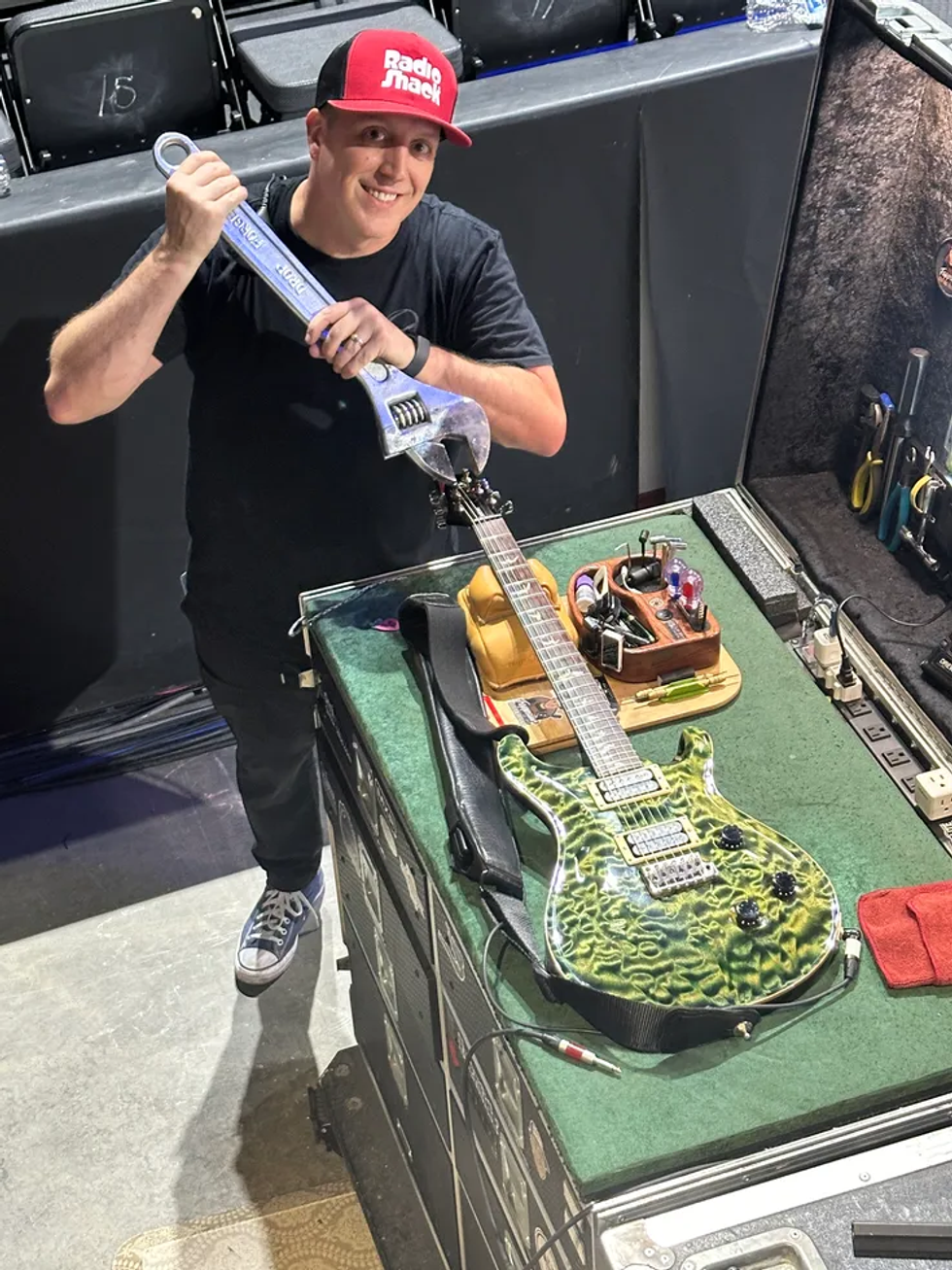
You earned a soccer scholarship and degrees in mathematics and psychology. How did you end up as a guitar tech?
Drew Foppe: I never planned to really be involved in music, ever. I wanted to do social work. But guitar kind of took over, and I just started following it. I got into a band and did that for about a year and a half. About five days after I quit, my buddies said, “Hey, why don’t you tech for Opiate for the Masses?” I was like, “What’s a tech?” [Laughs.] So I became a guitar tech, and haven’t stopped in almost 25 years.
Now you’re on the road with Shinedown, one of the biggest rock bands of the past few decades. What does a typical day look like for you when you’re on tour?
Foppe: When I get in, I immediately go and set up the warm-up room. The next hour and a half or so, I’ll change strings. That takes about three hours to do all 20 guitars. After I get done, I’ll get all the gear in position and start running all the cables for the keyboards, pedalboards, and all that stuff. Then it takes about 20 minutes to change all the wireless packs to the correct frequencies. Shortly after that, we line-check the gear with a crew jam. Everything’s pretty dialed at this point.
When the show starts, every single song is a guitar change, and they have four stages. I do about 10 to 12 miles of steps during a show!
Zach Myers’ love for gear is well known in guitar circles. Tell me about the rig you handle for him every show?
Foppe: We’re getting eight channels from Zach. There are three electric wireless lines and one acoustic. The acoustic goes out to a Fishman DI. The electric goes to two pedalboards. I have one in my tech world and one on the stage. From the boards, it goes to the [Fractal] Axe-Fx III. And from the Axe-Fx, we’re using Synergy power amps that hit two 112 ISO cabinets. We also send the amps to UA OX Boxes with a modeled 112 open back cabinet. Then there’s the outs from the Axe-Fx.
Digital modelers are usually employed to simplify signal chains. You obviously use them very differently. Do you pick a side in the digital vs. analog debate?
Foppe: I was probably right in the heart of when analog and digital were fighting for commonplace in the industry. Digital just gave you more options. Transitioning between the two, I think they’re integrated so well now that I don’t think it matters. I’ve done both for the biggest artists in the world, and stadium artists use digital and stadium artists use analog. They just use what they like and what they’re comfortable with.
You’ve worked with some incredible artists across multiple genres. Is there a secret to getting called back for the next artist or tour?
Foppe: I truly believe that having a psychology degree has helped me navigate these waters. When you’re working with artists who know exactly what they want, you just gotta listen and take it all in instead of coming in like, “I can do whatever. I can’t do whatever.” I think if you just listen to what people are saying, that gives you a good head start. That’s what really helps you grow as a tech and get other jobs.
Surrounding yourself with music, gear, and travel sounds romantic, but what are some truths about teching that you’d like to share with people considering it as a career?
Foppe: The first thing you’ve got to do is learn the craft of guitar repair, amp repair, programming, signal flow, and troubleshooting. All that stuff comes before you actually get a job. But the work aspect is only maybe 40 percent of the job. Working well with people and being self-motivated is pretty much everything else.
It’s also long hours, being away from your family, and you start to almost change your friend groups. That’s why they call it your “tour family.” So learning guitar skills, working well with people, and being okay to work when you’re tired is ultimately the key to being a guitar tech.
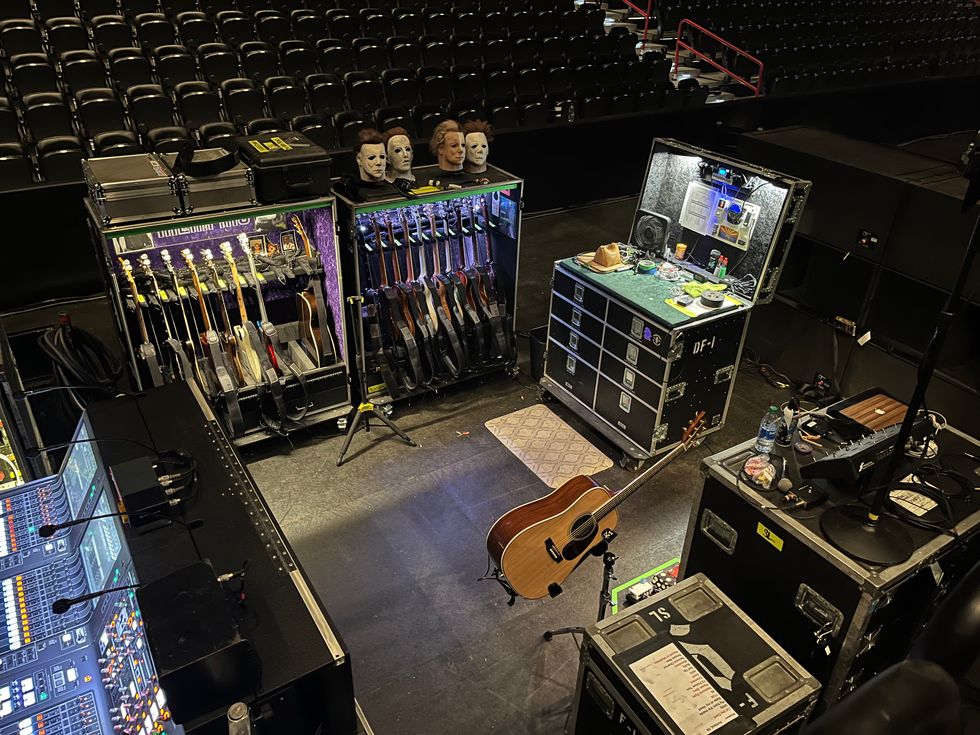
The three tools Drew Foppe can’t live without:
● Peterson Strobe Tuner
● Music Nomad String Action Gauge
● EarplugsWe Could All Stand to Learn More From the Bass
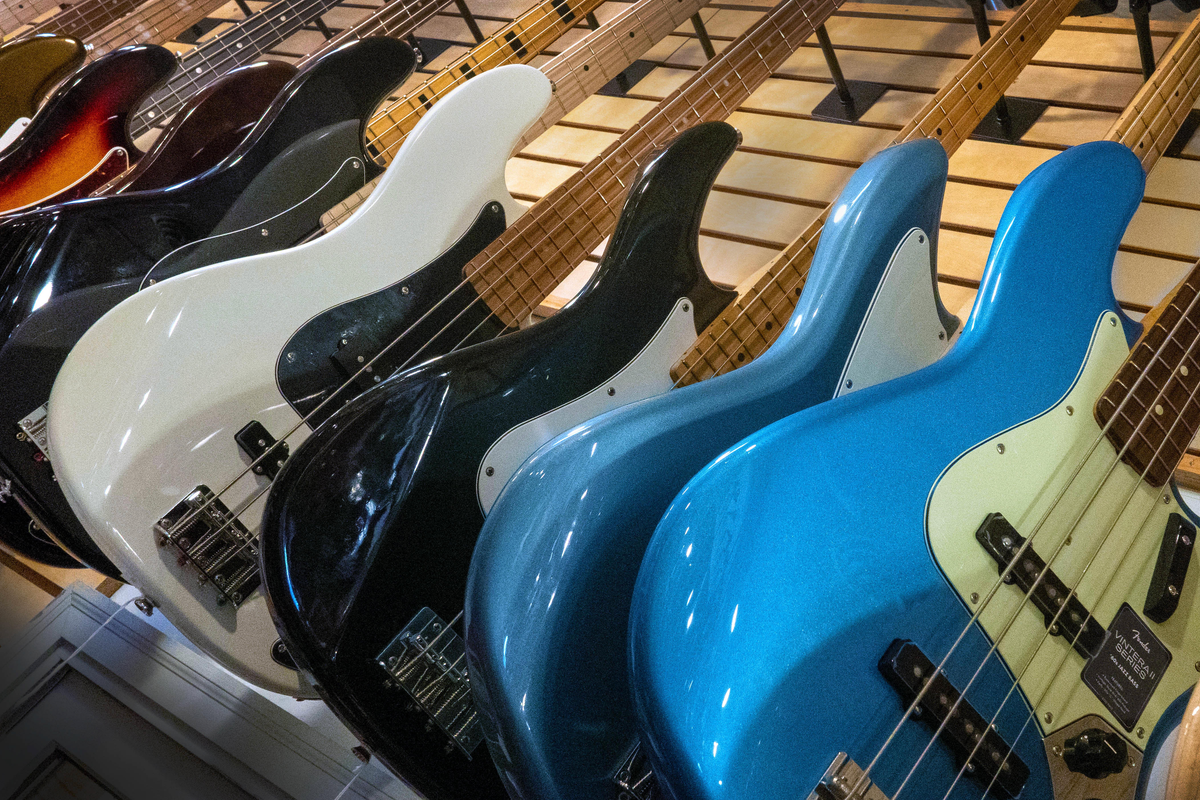
One of the most significant innovations in modern music is undeniably the electric bass guitar. There are conflicting opinions about who invented the idea and when, but it is without a shred of doubt that Fender brought it to the masses. Looking at the state of the instrument from where we are today it’s hard to believe there was a time when it didn’t exist. That alone tells you how important Fender’s contribution is. Sure, there are low notes on pianos, organs, and synths, but the utility and portability of the bass guitar beats these rivals by a mile. Despite all of this, the bass has often been treated like an afterthought.
Part of the reason might be that it’s easy for any guitarist to just pick one up and play it. After all, they’re tuned exactly like the lowest four strings of a guitar. In most cases, bass parts generally don’t require you to play those pesky and intimidating chords, and bendy dweedle-dweedle acrobatics are usually out of the question. All you have to do is stay in your lane and play the root and some passing tones. Throw in some octave jumps and you’re golden. Aside from the tambourine, it’s the simplest way to get into music. Or is it?
I first started playing guitar in a band with three guitarists and no bassist. We were all around 13 years old and had a very limited knowledge of what we were doing. Once we realized that most bands had a bass player, we pressured one of the guys to trade in his guitar—an all-white SG Junior—and get a bass. It made an immediate difference for the better.
One day at our weekly rehearsal, the bassist didn’t show up. As the lower-ranking guitarist, I was elected to strap on his Gibson EB-2 and carry on. With some disappointment, I plugged the bass into the bright-blue-and-brushed-aluminum Baldwin bass amp and plucked a note. I was thunderstruck. We launched into our first number as I attempted to navigate a slightly different, yet familiar highway. As I gained confidence, my attitude became gleeful. So much power underneath my fingers! Pretty soon I began to hope our bassist wouldn’t ever show up. As it turned out, the next week I was relegated back to playing those pesky chords on my 6-string, but the brute force and glory of the bass stuck with me. For decades it was my main instrument.
“Suddenly, bass tones I’d attributed to just the bass guitar were revealed to be multiple instruments.”
As a newly minted bassist I started paying more attention to bass parts on recordings and in live performances. I began to become more aware of how the bass worked with drums to form the foundation of the music I loved. When I listened to music I was familiar with, I suddenly heard things I’d missed for years. I was paying more attention to the way a rhythm section locked together, but I also heard how certain tones were created by the blending of percussion—mostly kick drum and toms with the bass. Suddenly, bass tones I’d attributed to just the bass guitar were revealed to be multiple instruments. This, of course, is because the drummer and bassist are listening to each other and weaving in and out of each other’s parts. I’d suggest that every guitarist or bassist take a crack at learning to play drums. Even a basic understanding of percussion will make you a better musician, producer, or recording technician. Hell, work on some keyboard chops while you’re at it. The more you appreciate different disciplines the better you’ll be, and you’ll enjoy music more, too. For a young musician, this was a revelation that put me on a path to appreciating different styles of music. That mindset has also spilled over into my work as an instrument builder. When you step outside of your chosen lane and see what creates the whole, you understand more about what’s important about music and instruments. As a guitarist this gives me a more holistic approach, too.
The list of truly masterful bassists that switched from guitar proves that playing the bass is not the demotion that some guitarists might say it is. Understanding the whole picture is the key. As it turns out, I was just another one of many guitarists who picked up the bass in unforeseen circumstances. Some of the best known guitarists-turned-bassists include Noel Redding, Paul McCartney, Tal Wilkenfeld, Walter Becker, Geezer Butler, and even one of the most prolific bassists in recording history, Carol Kaye. In this company, I’m happy to have accidentally become a bass player. For me, bass is not an afterthought—I regard myself as a reformed guitarist.
Wolfgang Van Halen thinks it’s a “miracle” Van Halen’s final album was even made
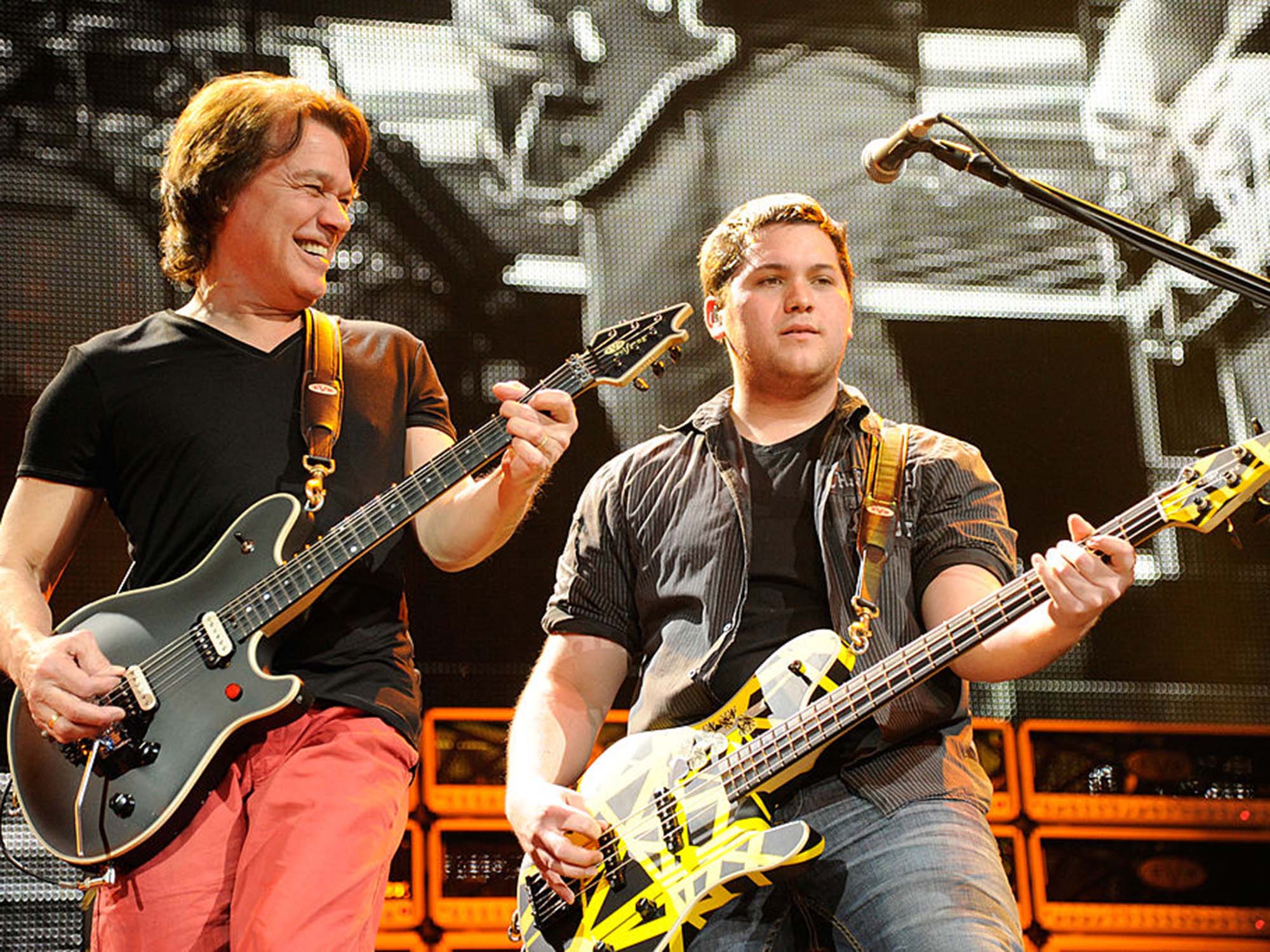
In recent years, Van Halen’s final record, A Different Kind of Truth, has faced its fair share of controversy. Most points of contention come from former frontman David Lee Roth, who has publicly slammed the 2012 release and allegedly even got the album pulled from streaming services between 2022 and 2024.
However, the slew of controversies hasn’t soured how the record feels to Wolfgang Van Halen. In a new interview with Noise11, the musician notes that A Different Kind of Truth was a “miracle” record that came together despite the odds.
- READ MORE: Wolfgang Van Halen admits he finds it “bittersweet” to play his father’s iconic Frankenstein guitar
A mishmash of new tunes and “earlier demos recorded in 2009”, A Different Kind of Truth certainly wasn’t an easy record to piece together. “It took a long time…” Wolfgang admits. “A lot of [the tracks] were rooted in original demo ideas that were never completed. We thought it was a great way of getting the band back into that mindset of how they used to write music.”
“The fact that that record happened at all, I think, is kind of a miracle,” he notes. “But we pulled it off.”
Despite the difficulties, Wolfgang notes that the experience of using the old demos in the studio was like planting a “little seed” to then grow the record from. And it was one of the only chances Wolfgang would have to make a record with his father, Eddie Van Halen.
“I’m glad I got to at least do that once with Dad, have that making-an-album [experience],” he explains. “It was fun. It was a lot of work and it took a lot of time, but I’m very happy with how we got it done.”
Of course, David Lee Roth will probably never see the “fun” in the record. Last February, Roth posted a now infamous YouTube video entitled ‘Family Therapy..’ sharing his views on the 2012 release. In it, the singer labels the release as ‘dead on arrival’, ‘a complete faceplant’ and a sign of Van Halen being ‘kicked to the curb’.
The post Wolfgang Van Halen thinks it’s a “miracle” Van Halen’s final album was even made appeared first on Guitar.com | All Things Guitar.
Fender launches the American Professional Classic series, the new entry point to its USA-made lineup

Fender has unveiled the all-new American Professional Classic series, shifting the hierarchy of its USA-made product lineup.
The new range replaces the American Performer range, entering above the Mexico-made Player II line and below the American Professional II series, which launched in 2020. Thus, the American Professional Classic series sits as the new entry point to the brand’s American-made instruments.
The American Professional Classic series – which comprises nine instruments (six guitars and three basses) – is pitched to offer “reliability, versatility and performance at the highest level”, with the tagline: “Tested. Trusted. Night After Night.”
The result is a line of guitars which is deeply rooted in the tried-and-tested Fender blueprints, but with spec sheets geared towards the modern player, including a number of forward-thinking appointments, not least all-new Coastline pickups.
These new pickups are ever-so-slightly overwound, and based on the firm’s Pure Vintage models, for enhanced clarity, punch and dynamic expression, and for “Fender’s signature warmth and bite across every register”. Essentially, it’s classic Fender tone, but hotter.
Other key appointments include enhanced neck profiles – Modern C-shaped with rolled fingerboard edges for speed and playing comfort – as well as upgraded hardware, including vintage bridges and precision ClassicGear tuning heads for “rock-solid” tuning stability.
The line also comes in a curated selection of classic fender finishes, reimagined for modern players with fresh and vibrant options.
Specifically, there’s a classic triple-single-coil-loaded Stratocaster, HSS Strat, Telecaster, Hotshot Telecaster – a successor to the triple-pickup Nashville Telecaster – as well as a Jazzmaster and Jaguar. In the bass department, there’s a Precision Bass, Jazz Bass and a Mustang Bass.
“The American Professional Classic is all about delivering a great playing experience,” says Max Gutnik, Chief Product Officer at FMIC.
“We focused on every detail: from the all-new Coastline pickups, which offer clear, punchy tone across every register, to the Modern-‘C’ neck with rolled fingerboard edges that feels comfortably broken-in from day one.
“We combined vintage-inspired finishes and hardware with thoughtful upgrades like staggered ClassicGear tuners, Mustang saddles on the offsets, and slotted Telecaster barrel saddles. The result is a guitar that’s easy to play, sounds incredible and adapts to any style or stage.”
tuners, Mustang saddles on the offsets, and slotted Telecaster barrel saddles. The result is a guitar that’s easy to play, sounds incredible and adapts to any style or stage.”
Fender have tapped Baltimore hardcore outfit Turnstile to front the campaign. Check out the guitars in action during Turnstile live shows in the video below:
“When you’re in a different place constantly, sometimes the most familiar thing is the guitar that you bring every single night,” says Turnstile’s Pat McCrory.
“We look for something that sounds the same every time, sounds exactly how you want it, but also has versatility because spaces change. Sometimes you play outside, sometimes it sounds different, sometimes you play inside or there’s noise lighting. Having some durability but flexibility is very important.”
Pricing for the American Professional Classic series is as follows:
- American Professional Classic Stratocaster – £1,499 / $1,499
- American Professional Classic Stratocaster HSS – £1,549 / $1,549
- American Professional Classic Telecaster – £1,499 / $1,499
- American Professional Classic Hotshot Telecaster – £1,549 / $1,549
- American Professional Classic Jazzmaster – £1,599 / $1,599
- American Professional Classic Jaguar – £1,599 / $1,599
- American Professional Classic Precision Bass – £1,549 / $1,599
- American Professional Classic Jazz Bass – £1,549 / $1,599
- American Professional Classic Mustang Bass – £1,499 / $1,599
Learn more about the American Professional Classic series at Fender.
The post Fender launches the American Professional Classic series, the new entry point to its USA-made lineup appeared first on Guitar.com | All Things Guitar.
Frank Zappa’s prized “Baby Snakes” SG is headed to auction – and could fetch $500,000

Frank Zappa’s legendary “Baby Snakes” SG – a heavily modded Gibson SG copy used extensively by the prog hero both onstage and in the studio – is headed to auction, and could fetch up to $500,000, according to some estimates.
Zappa first acquired the guitar from 19-year-old luthiery student Bart Nagel in July 1974, backstage at a show in Phoenix, Arizona. Prior to the sale, Nagel had replaced its neck for a three-piece mahogany neck, topped with a 23-fret ebony fingerboard with custom inlays.
After purchasing the guitar, Zappa gave it to luthier Rex Bogue for a series of mods to its electronics, like a custom onboard preamp with an 18dB boost and phase switching for a wider array of available tones.
According to Heritage Auctions, the auctioneer in charge of the lot, the guitar was used both onstage and in the studio, with one notable appearance being Frank Zappa’s Mike Douglas Show performance in 1976.
Bidding for the guitar will start at $300,000 on 5 December, and auctioneers are expecting the six-string to sell for a whopping half a million dollars.
“Hitting the market for the very first time, the ‘Baby Snakes’ SG is a true artifact of musical genius,” says Aaron Piscopo, Heritage’s Director of Vintage Guitars & Musical Instruments. “This guitar embodies the boundless intelligence, innovation, and creativity that defined Zappa’s career.”
“Deeply modified to suit Zappa’s avant-garde sonic explorations, the ‘Baby Snakes’ guitar was more than an instrument – it was a vehicle for innovation, experimentation, and artistic rebellion,” adds Heritage Auctions.
“With its ornate aesthetics, 23-fret neck, onboard preamp, and signature tone-shaping electronics, this is the guitar that helped define Zappa’s post-Mothers live sound.”
Learn more about Frank Zappa’s “Baby Snakes” SG at Heritage Auctions.
The post Frank Zappa’s prized “Baby Snakes” SG is headed to auction – and could fetch $500,000 appeared first on Guitar.com | All Things Guitar.
“People have a hard time understanding how unsurprising Bohemian Rhapsody was to us”: Brian May recalls people’s reactions to hearing Queen’s magnum opus for the first time

Bohemian Rhapsody exists in a world of its own. The 1975 track is bursting with piano-led confessions of murder, operatic might and one of the most iconic guitar solos of all time – but, if you ask Queen, there’s nothing particularly ground-breaking about it.
In a new interview with Classic Rock, guitarist Brian May reveals that, in the studio, Bohemian Rhapsody was just another standard Queen cut. “People have such a hard time understanding how unsurprising Bohemian Rhapsody was to us,” May says. “If you look as the first album, you’ve got My Fairy King, which is very complex and goes all over the place.”
Fans and peers alike were stunned by the intricacies of Bohemian Rhapsody; apparently producer Roy Thomas Baker laughed in shock when the eccentric Freddie Mercury explained his plan to include an operatic break in the track. But, with a strong back catalogue of absurdities, May wasn’t shocked by Mercury’s ambition.
In May’s opinion, March Of The Black Queen, which dropped a year earlier than Bohemian Rhapsody in 1974, is “way more complicated” than their stand-out hit. “[It was] on the second album, and it is enormously complicated. “So, Bohemian Rhapsody wasn’t a surprise to us” he explains. “It was just: ‘we’ll do another one of these things.’”
Drummer Roger Taylor was equally as comfortable with Bohemian Rhapsody’s unconventional structuring. “As we were constructing the opera bit, we were getting more and more wild,” he recalls. “‘Stick a bit more on, stick another bit in, it’ll all be fine when it gets to the heavy section.’ And it was.”
Despite the operatic sections being written by Mercury, who “knew nothing about opera”, the track was just another way of exploring the band’s musical potential. “We were planting our flag in the ground: ‘This is really us – it’s a bit mad but it’s got everything in it,’” Taylor explains.
While the pair admit they don’t know exactly what the track is about, with May noting “we never really asked each other about our lyrics”, the track continues to be a fan favourite. For that reason, it continues to be a staple for live shows – despite the fact May struggles to play it.
“It’s the most unnatural riff to play you could possibly imagine,” he admitted last year in a chat with Total Guitar. “It’s not a riff that a guitarist would naturally play… and that’s a double-edged sword.”
“It’s difficult for the guitar to get a hold of it, but once you have got hold of it, it’s very unusual,” he continues. “And to be honest, I still don’t find it easy! I can play it at home okay, but in the heat of the battle, when we’re playing it live, and there’s huge adrenaline, it’s the climax of the show and that riff comes along, it’s not the easiest thing to play.”
The post “People have a hard time understanding how unsurprising Bohemian Rhapsody was to us”: Brian May recalls people’s reactions to hearing Queen’s magnum opus for the first time appeared first on Guitar.com | All Things Guitar.
Richie Faulkner on the “pressure” of nailing Judas Priest’s Painkiller guitar parts live: “You can’t mess it up – you’ve got one shot at it”

It’s no small feat to be tasked with assuming lead guitar duties for Judas Priest, one of the most iconic metal bands to ever exist.
Richie Faulkner is, of course, up to the task, but as he explains in a new interview with TribLive, he still feels the pressure to nail his guitar parts live, even after having been a member of the outfit since 2011.
Pointing specifically to 1990 album Painkiller – of which the band is currently celebrating its 35th anniversary on tour – Faulkner reveals: “Whenever we play a song from the Painkiller record or when Rob mentions the Painkiller record, the roof just lifts off the room.”
The Painkiller album features, in addition to its ferocious title track, the likes of Night Crawler, Leather Rebel, A Touch of Evil and One Shot at Glory, with guitars played by KK Downing and Glenn Tipton.
Faulkner goes on: “To be back playing a celebration of that record is always uplifting from our point of view and the crowd as well.
“And the guitar playing on that record is stunning, as we all know: Painkiller, One Shot at Glory, Hell Patrol. All those tracks are relentless guitar playing, like a master, you put that on, learn that and you’ve probably got everything down in your toolbox for heavy metal guitar.
“It’s great to play live because you can’t mess it up, you’ve got one shot at it, you’ve got to get it right or close to right the first time. So it’s a bit of a challenge as a guitar player, but it’s really fun to play and the audience loves it, too.”
But while it’s important for Richie Faulkner to nail the classic guitar parts laid down by KK Downing and Glenn Tipton, he acknowledges that, on fresh Priest material, he wants to inject his own voice and style.
“It’s always been a hard thing for me to have my own voice,” he says while recounting the writing process for the band’s latest album Invincible Shield.
“I played in cover bands when I was younger, and so you make a living emulating everyone else. So you emulate everyone else, but you haven’t got your own voice. So it’s always been a challenge for me to have my own voice.
“So I always try and add a little bit more of whatever my voice is on the guitar solos. Something that if someone put the record on, they can identify it as mine. I don’t know if I ever achieved that. That’s not really for me to say. That’s for the listener to decide really, but I always try to do that, something that has my character in there somewhere, if that’s possible to do.”
In other news, Richie Faulkner recently revealed he works “three times a day” with a physio while on tour, to manage the damage caused by an aortic aneurysm and stroke he suffered onstage in 2021.
For a full list of upcoming Judas Priest tour dates, head to the band’s official website.
The post Richie Faulkner on the “pressure” of nailing Judas Priest’s Painkiller guitar parts live: “You can’t mess it up – you’ve got one shot at it” appeared first on Guitar.com | All Things Guitar.
The guitar influences of Kurt Cobain

Influences are incredibly important when it comes to musicians developing their own style. Some musicians can become the sum of their influences, while others will find their own voice after being inspired by the artists who came before them – Kurt Cobain is the latter. His brilliant songwriting was highlighted by the way he used his instrument. His goal was never to be flashy or impress anyone with his sweep picking – it was to accentuate the artistic statement he was trying to make, and he was unquestionably successful in his endeavor.
Nevertheless, we can learn a lot by examining the guitarists who influenced the way that Cobain played, both sonically and technically. So, in this article, we’ll take a look at some of the guitarists whose playing helped guide Kurt Cobain to be the musician we all know him as today.
Buzz Osborne
Kurt Cobain frequently acknowledged Buzz Osborne as a mentor and an influence. Their music-centric kinship was a much more personal influence on Cobain’s guitar playing than simply admiring the handiwork of Jimmy Page. Osborne was a local person with whom Cobain could actually talk about his musical ideas. Osborne was an important figure in Cobain’s music journey – a Samwise to his Frodo, if you’ll indulge that overly nerdy metaphor.
Lead Belly
In 1989, while Kurt Cobain and Mark Lanegan were busy establishing their own bands, they got together to record a series of Lead Belly cover songs for a tribute project they were going to call The Jury. Lead Belly was an early blues musician that Cobain has expressed a lot of admiration for – Bob Dylan also credited Lead Belly for getting him interested in folk music.
Cobain and Lanegan’s version of Where Did You Sleep Last Night ended up being the final track on Nirvana’s Unplugged performance and Mark Lanegan put a version on one of his solo albums. Cobain’s main acoustic used on songs like Polly and Something in the Way was a 12-string Stella, which was likely a tribute to his hero Lead Belly.
John Lennon
It’s probably fair to say that everyone has been influenced by The Beatles or a derivative in one way or another. The Beatles were such a cultural force that it’s hard to ignore them completely if you are a musician. Cobain specifically found John Lennon to be an inspiration. In a 1992 interview with The Advocate, Cobain said, “John Lennon is definitely my favorite Beatle…I just like his attitude. He’s not a great musician, but he’s a great songwriter.”
It was evident that Cobain looked to Lennon, not for his technique or tone, but for more of an overarching blueprint for how to approach the guitar, as simply a tool for writing great songs. As we know, Cobain steered well clear of flashy playing, which helped to shift focus to the songwriting. This was a similar tactic to how John Lennon operated in The Beatles.
Greg Sage
Kurt Cobain has publicly commented on his love for the band Wipers, particularly the songwriting and playing style of guitarist and vocalist, Greg Sage. Wipers were an early punk band who started back in 1977 in Portland, Oregon. Nirvana covered Wipers songs like D-7 and Return of the Rat, on early albums. Furthermore, Sage was a left handed guitarist. I’m not sure if that had anything to do with Cobain being drawn to him. It seems more likely that Cobain loved punk rock and Wipers, while not widely known, were very popular in the early Northwest punk scene.
Warren Mason
This is a name you may not recognize as he was another local person in Cobain’s early musical development. Warren Mason was a guitar teacher who gave a young Cobain guitar lessons for a few months while Cobain was in high school. Cobain’s family eventually pulled him out of the lessons due to poor performance in school. Mason passed away in 2021 but was remembered as a supportive teacher who encouraged creativity. He has said in interviews that Cobain wanted to learn to play Stairway To Heaven. Krist Novoselic also took lessons from Mason. Mason was in a couple of local bands, one was called Fat Chance, which featured Cobain’s uncle on drums. I won’t claim that Mason was a profound influence on what would come to be Cobain’s signature sound, but he was elemental in providing the basis for him learning to play guitar. Guitar instructors are far too often the unsung heroes of the music industry.
Joey Santiago & Black Francis
It’s no secret that Nirvana was heavily influenced by the Pixies, Kurt Cobain even going so far as to say in a January 1994 interview with Rolling Stone, “[With Smells Like Teen Spirit] I was trying to write the ultimate pop song. I was basically trying to rip off the Pixies. I have to admit it [smiles]. When I heard the Pixies for the first time, I connected with that band so heavily I should have been in that band—or at least in a Pixies cover band. We used their sense of dynamics, being soft and quiet and then loud and hard.”
Joey Santiago’s unconventional guitar solos seemed to resonate with Cobain as well as he would often use the space in a song where usually there would be a solo to make a statement with his note choices rather than show off some fancy shred technique he’d been working on.
The Pixies also had an influence on Nirvana’s production, citing Surfer Rosa as one of the main reasons they approached Steve Albini to produce their final studio album In Utero, in 1993.
This is by no means meant to be a comprehensive list. I tried to stick to artists that Cobain directly referenced in interviews for the purposes of this article. But Cobain was heavily influenced by such a wide array of music – he allowed himself to be inspired by everyone from Flipper and Black Flag to ABBA and Jimmy Page. If there is a lesson to be learned from exploring Cobain’s musical roots, perhaps it’s that – explore all the music you can and allow yourself to be inspired
The post The guitar influences of Kurt Cobain appeared first on Guitar.com | All Things Guitar.
Monger Pedals Unveils Boiling Honey Optical Tremolo and Little Guy Fuzz/Phaser
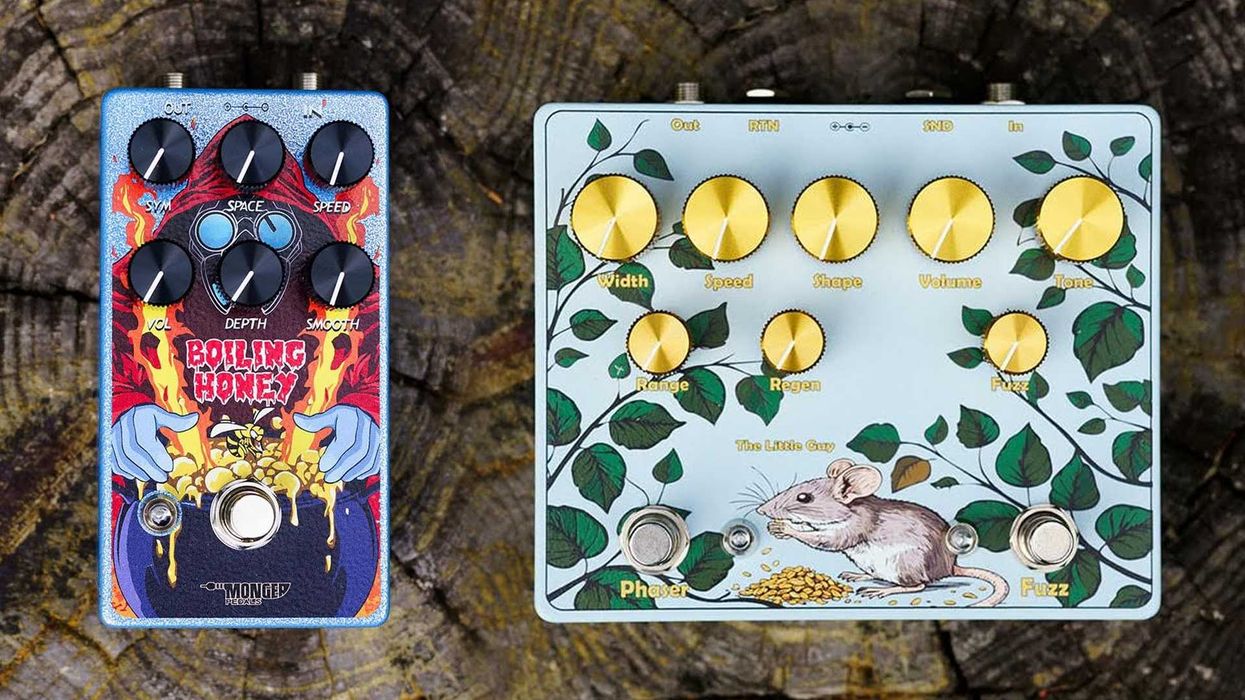
Adding to a lineup of versatile sound shaping guitar effects,boutique effects firebrand Monger Pedals has launched a pair of provocative new pedals: theBoiling Honey tremolo and Little Guy fuzz / phase shifter.
Boiling Honey
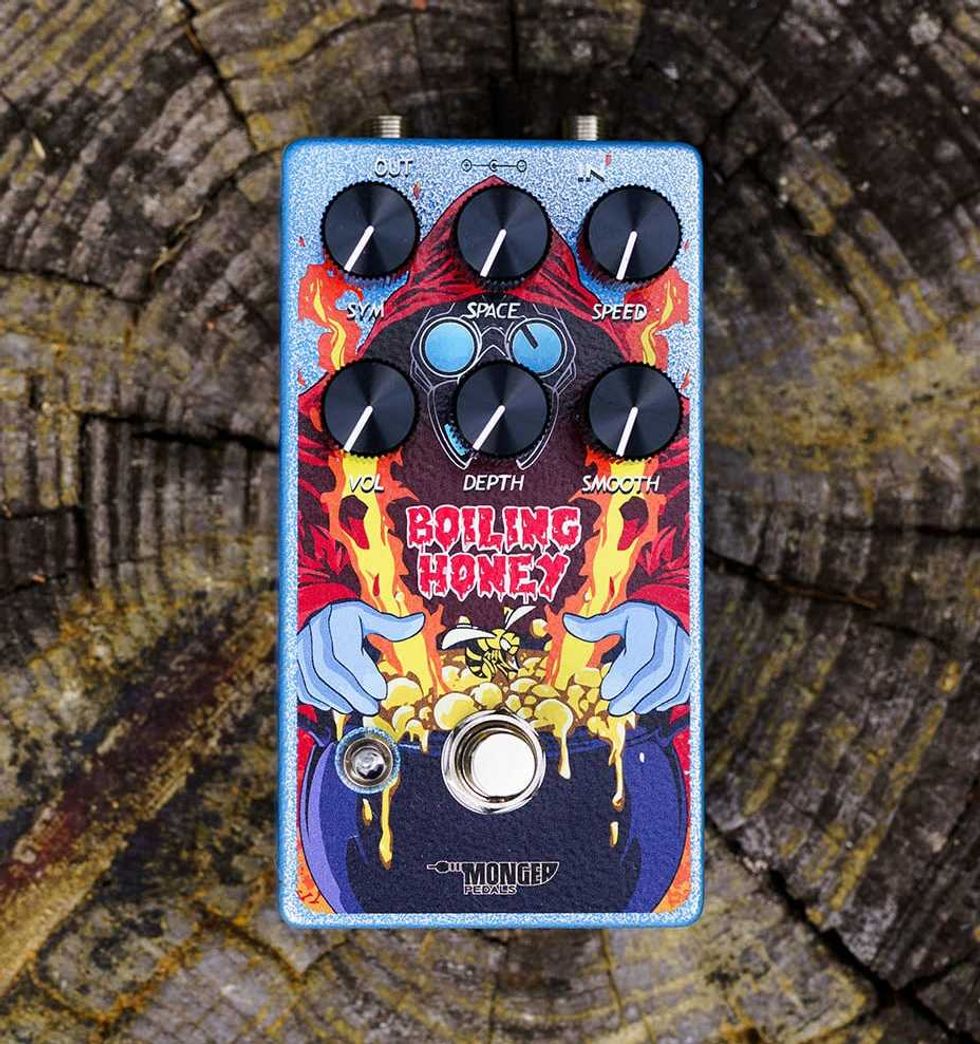
The Boiling Honey is an optical amplitude tremolo that delivers rich, pulsing modulation with a distinctly organic character. From smooth syrupy sways to sharp stuttering chops, it captures both warmth and bite in a single unit.
Boiling Honey features include:
- Analog optical amplitude tremolo
- 6 controls - Shape, Space, Speed, Volume, Depth, Smooth
- Rate LED shows what each control does internally
- True Bypass, Standard 9v operation, Top-mounted I/O
The Little Guy
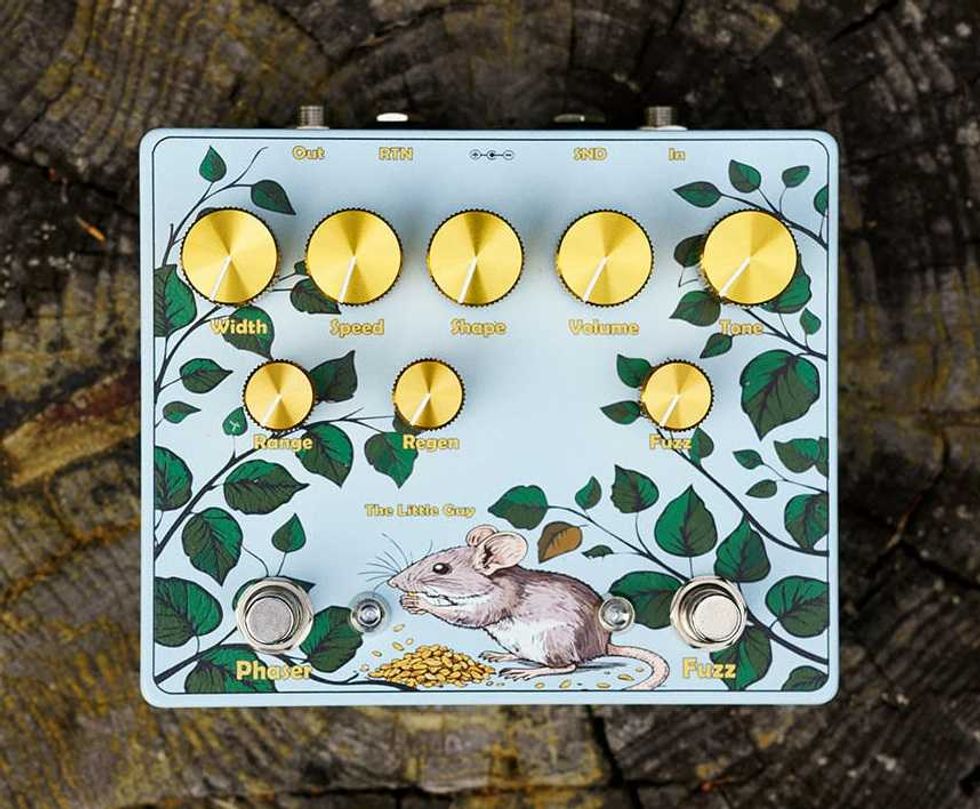
The Little Guy offers an extremely versatile two in one effect, combining fuzz and phase shifting into a single package designed to deliver a wide range of sounds. The phaser can shift frequencies and waveform shapes, while the fuzz keeps clarity and is extremely responsive to guitar input.
Little Guy features: include
- Fully analog modulation
- Two effects in one package with an internal signal chain from fuzz to phaser
- Send and Return input/output jack to break up the internal signal chain to allow for easy placement into your effect chain.
- Phaser controls for: Width, Speed, Shape, Range, Regen. Allows for infinite possibilities
- Fuzz controls for: Volume, Tone, Fuzz
- True bypass footswitches, 9-volt standard DC input, top mounted I/O
The Boiling Honey tremolo carries a street price of $145.00, and the Little Guy fuzz/phaser is priced at $224.99. Both pedals can be purchased directly from the Monger Pedals online store at www.MongerPedals.com.
Stompboxtober 2025: Xotic Effects

Turn up the tone! Enter today’s Stompboxtober giveaway to WIN the Xotic AC Booster V2 — responsive overdrive with touch sensitivity, classic warmth, and tonal shaping via dual EQ + DIP switches. Don’t forget to stomp back tomorrow for your next chance to score gear!
Stompboxtober 2025 - Win Pedals All Month Long!
Xotic Effects AC Booster V2
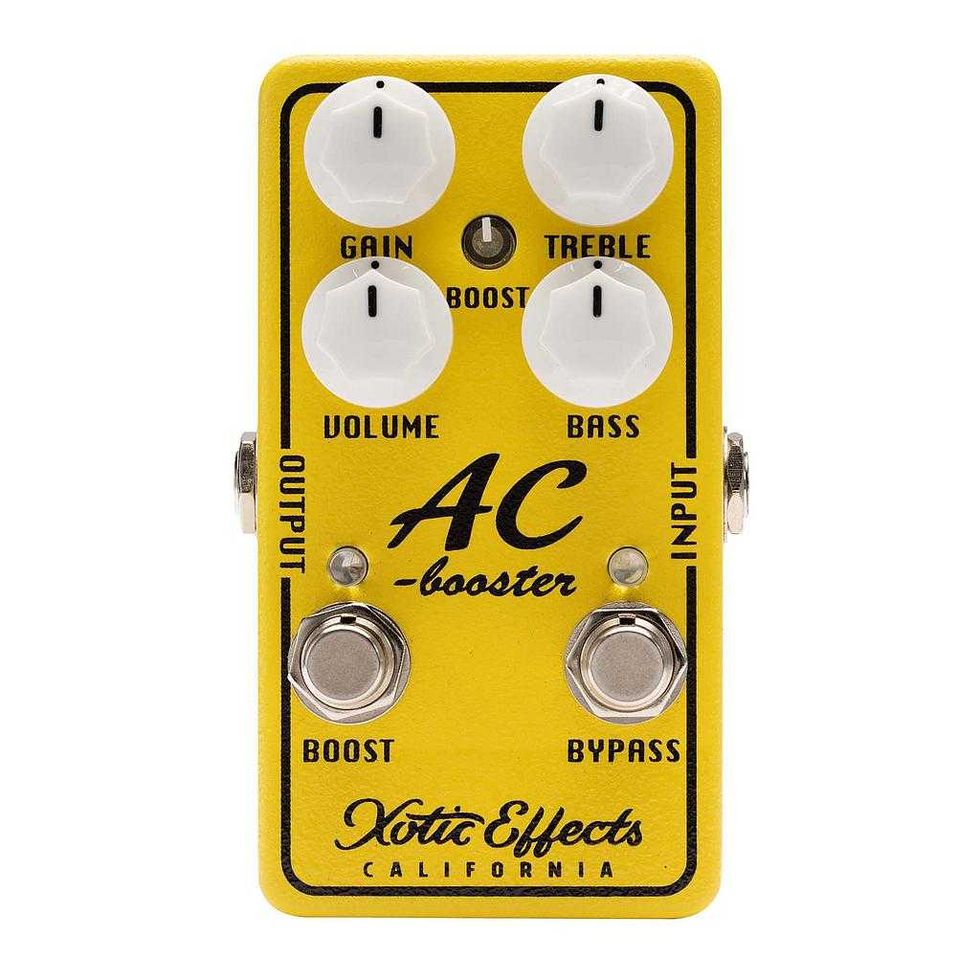
Reacting exactly like a great tube amp, the newly designed AC Booster V2 offers a wide range of overdrive with touch sensitivity just like the original AC Booster.
You can set it up to get a crunchy warm overdriven tone and with just a little rolling off of the guitar’s volume, it will give you a great clean sound.

Xotic AC Booster V2 Overdrive Pedal
Joe Walsh: The Classic Classic Rock Guitarist with Greg Koch | 100 Guitarists Podcast
When you think of classic rock guitar, what do you hear? Who is the most classic of all classic rock guitarists? We have a theory, and we tapped Greg Koch, the hard-touring, hard-rocking Gristlemaster himself, to join us and test it out. Is it Joe Walsh?
From his time with the James Gang through joining the Eagles and embarking on a successful, hit-laden solo career, Walsh epitomized the sound of ‘70s rock guitar riffs and solos. There’s a reason he eventually found his way to Ringo’s All-Starr Band! So is he the definition of classic rock?
Also, Greg takes this opportunity to chat about his Oasis obsession and shares his favorite Beach Boys song.

Learn More! www.gibson.com
Nembrini Audio Launches The Hughes & Kettner Tube Rotosphere Plugin
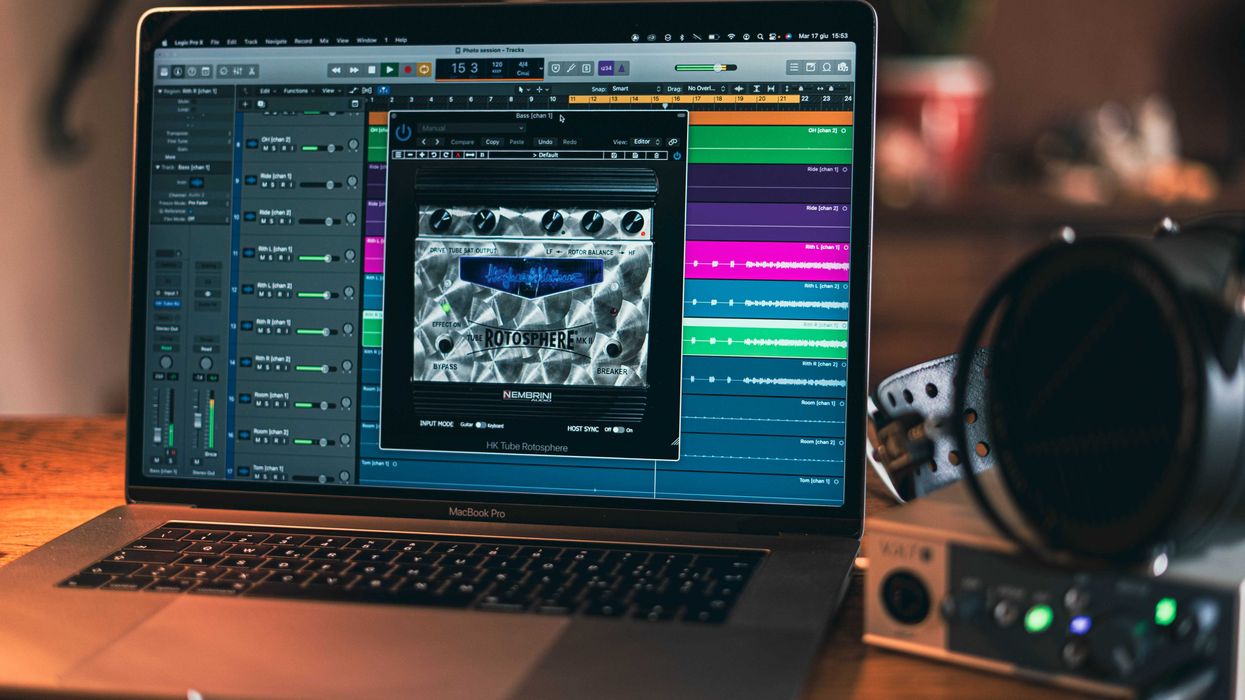
Nembrini Audio is pleased to launch the Hughes & Kettner Tube Rotosphere plugin, an authentic digital emulation of the acclaimed Hughes & Kettner Tube Rotosphere MKII Rotary Speaker* simulator. Listen to it here and see it here.
In the 1960’s the Leslie Speaker System*, originally developed in the 1930’s for the Hammond Organ, began to be used for guitars by The Beatles, Eric Clapton, David Gilmour and more. In the 1990’s Hughes & Kettner, a highly respected manufacturer of instrument amplifiers, cabinets and effect boxes, created the Tube Rotosphere pedal, an extremely accurate, analog reproduction of the Leslie Speaker System.
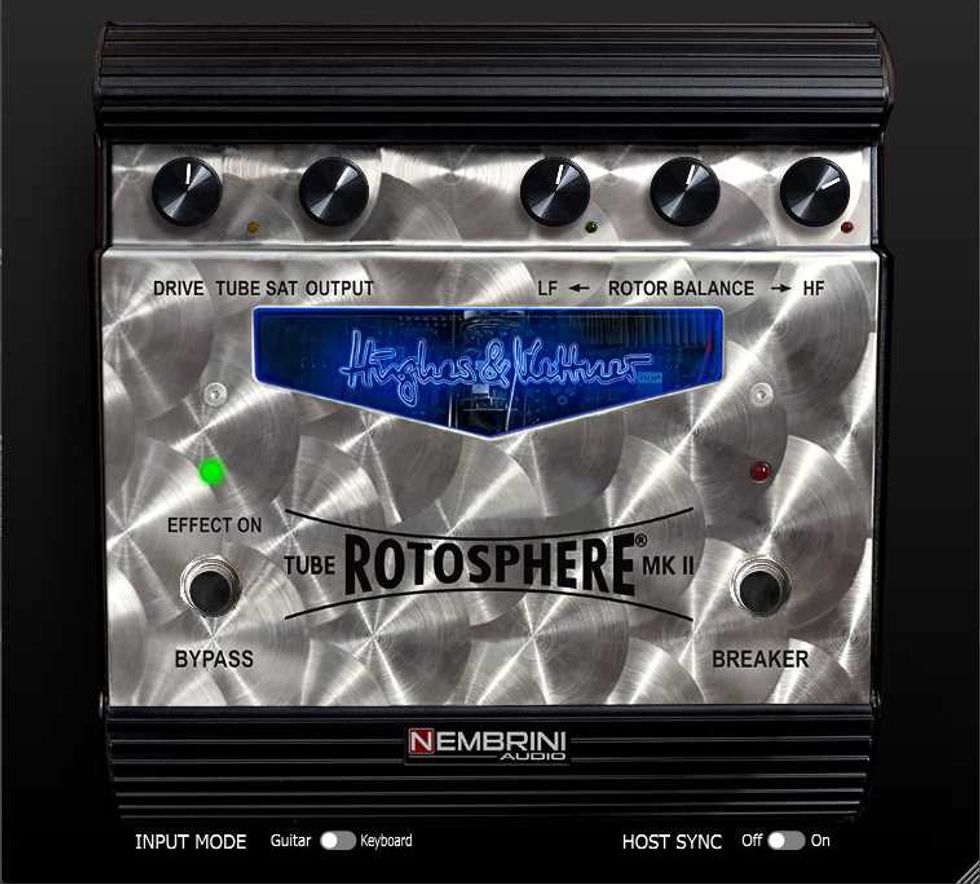
More than thirty years later, Nembrini ‘s new plugin breathes fresh life into this cool sound with the introduction of a realistic digital simulation of the much admired Hughes & Kettner Tube Rotosphere. Celebrated for its rich tube-driven character and highly musical rotary modulation, the original hardware was used keyboardists and guitarists seeking the iconic swirling depth of a classic rotary cabinet, with the warmth of real tube saturation. The new Hughes & Kettner Tube Rotosphere plugin faithfully captures every nuance of its analog counterpart, offering everything from subtle to dramatic Doppler-infused motion, with can be seamlessly integrated into any rig.
Nembrini’s advanced modelling technology captures all of the lush swirl, warm tube saturation and authentic rotary motion of the original pedal. The key features of the new plugin include true to life emulation of the analog circuitry and tube preamp behaviour, independent rotor speed simulation with separate LF and HF controls allowing precise adjustment and a breaker switch for realistic ramp-up/down and rotor stop effect. There is also tube saturation modelling with visual feedback, rotor balance control for fine tuning the blend and a stereo signal path for wide, immersive rotary modulation.
The Hughes & Kettner Rotosphere plugin desktop version is available at the introductory price of $29.99 (normally $99) until the October 31st 2025.
To find out more and download the Hughes & Kettner Rotosphere plugin please go to www.nembriniaudio.com/products/hughes-kettner-tube-rotosphere.
Eric Gales downplays those who praise him as the best guitarist in the business: “I turn on YouTube or Instagram and see some of the baddest players in the world!”

There’s no denying Eric Gales possesses some of the best guitar chops in the business. And that’s not counting the fact that the left-handed virtuoso plays a right-handed guitar upside down.
And while he’s appreciative of those who would go as far as to call him the very best guitarist in the world, Gales is quick to point to the level of talent that exists out there, particularly on social media.
“I take it as the highest compliment,” he tells Classic Rock in its new print issue. “I put a lot of years and hard work into my craft, and for people to have that mindset about me is larger than life for me.”
He explains that opening YouTube or Instagram is a quick route to seeing some of the finest guitar talent out there today: “I turn on YouTube or Instagram and I see, in my opinion, some of the baddest players in the world, doing some stuff that is completely mind-boggling,” he says. “My mind is flipped upside down by the stuff I’m seeing.
“But at the end of the day, when the question gets asked who do they think is the baddest motherfucker in the world, they still say, ‘Eric Gales.’ That’s huge for me, man.”
Elsewhere in the interview, Gales reflects on A Tribute to LJK, his new album and a collection of his late brother Manuel’s songs recorded by Eric.
“The record is my way of giving honour to my older brother, [who’s] been gone for over 20 years now,” he says, reflecting on Manuel’s (Little Jimmy King) passing in 2002.
“I decided to do some of his songs, through my eyes, with a 2025 approach, to show the world exactly how badass he was, incorporating some allies and friends of mine. I’m ecstatic with it, man.”
He later adds: “[I’m] happy that I’m able to make a project that brings memory to him. Excitement. Happiness. Sadness. It overcame me here and there, but I held it together, because I knew there was a job that needed to be done.
“I’m sure I’ll see my brother again. And not only him. I got other family members [who have] passed on too. And I believe I’ll see them again. I’m sure of it.”
Eric Gales’ new album A Tribute to LJK is out now.
The post Eric Gales downplays those who praise him as the best guitarist in the business: “I turn on YouTube or Instagram and see some of the baddest players in the world!” appeared first on Guitar.com | All Things Guitar.
Sammy Hagar says this Van Halen classic sounds “as good as it sounded for 20 years” with Michael Anthony singing instead

Sammy Hagar has sung the praises of bassist Michael Anthony, saying his longtime bandmate can now confidently perform lead vocal duties on some Van Halen classics.
Lately, Hagar’s been showing more love to Van Halen’s Roth-era hits – something he admits wasn’t always his thing. At his recent Best of All Worlds Las Vegas residency shows, the singer tackled Panama himself, while Anthony took the mic on various fan favourites like Ain’t Talkin’ ’Bout Love, Somebody Get Me a Doctor, and Runnin’ With the Devil.
In a recent chat with Ultimate Classic Rock, the former frontman admits he’s been especially impressed by Anthony’s evolution as a singer, noting how the bassist has moved far beyond his days of providing tight, “sterile” backing harmonies to become “a really good lead vocalist.”
“I like to get Mikey to sing lead, because he sings freaking great,” says Hagar. “People always just hear his background vocals, [but] he’s becoming a really good lead vocalist. Early on, he wasn’t, because he was always used to singing background.”
He explains that background singing requires a more restrained approach but says Anthony has since broken free of that.
“When you sing background, you have to sing very sterile. You have to sing the note and you can’t put any inflection on it or nothing. That’s the lead singer’s job. So the harmony guy has to sing very straight and very on key, and just nail the note and then hold the note [with] very little movement.”
“So when he was singing lead, it was [initially] a little stiff like that. But not anymore,” says Hagar. “In the last couple years, man, Mike’s come around. I’m listening to him sing Ain’t Talkin’ ‘bout Love and in my opinion, it sounds as good as it sounded for [the past] 20 years with him singing [it instead].”
That said, there are still a few songs Hagar keeps for himself.
“Panama is my favourite. You know, that’s the one I want to sing,” he laughs. “I don’t let Mikey sing Panama, because I like singing it. It’s a really fun song to play and sing. It’s badass.”
According to Hagar, revisiting these tracks isn’t just nostalgia; it’s about celebrating the full legacy of Van Halen, both eras included.
“We add those songs to the set because we’re doing a lot of Van Halen stuff,” he says. “Unlike the other guys that didn’t want to play my era, or can’t play my era. I like playing those songs, and I can play and sing those songs, and I think everyone appreciates them.”
The post Sammy Hagar says this Van Halen classic sounds “as good as it sounded for 20 years” with Michael Anthony singing instead appeared first on Guitar.com | All Things Guitar.
“There’s so much baggage that comes with a Strat”: Why Chris Buck is ditched his Fender for a Yamaha Revstar

Iconic as the Stratocaster may be, its history also comes with a heavy set of expectations.
St. Vincent, for one, previously described the Strat as burdened with the “cultural baggage” of “a history of people trying to play like Jimi Hendrix and sucking”, a pressure that “scared” her off the instrument for years.
And now, Cardinal Black guitarist Chris Buck says he too stepped away from his Strat, trading it for a Yamaha Revstar to escape the “baggage” that comes with playing one of the world’s most legendary guitars.
Chatting in a new Guitar World interview, the longtime Fender player looks back on the first time he encountered the Revstar: “I walked into a guitar shop in Cardiff and the Revstar had just been released. This would have been like late 2015, maybe. I saw a selection of them on the wall and was immediately intrigued… There were always Yamaha acoustics around the house as well, so Yamaha was always a brand that I was kind of cool with.”
“I just loved the idea of the Revstar being a new guitar,” says Buck. “It wasn’t an S type, it wasn’t a T type, it wasn’t a Les Paul, it was its own thing, and just such a simple, ergonomically kind of attractive guitar – three-way switch, master volume, master tone, two pickups… boom, you’re away.”
But Buck’s reasoning went beyond design. Playing a Strat had started to feel like carrying the weight of history.
“Part of me was getting a little bit miffed or kind of just annoyed with the idea that playing a Strat – as I had done for a very long time until that point – there’s so much baggage that comes with a Strat, arguably more so than any other guitar, because it’s such a distinctive sounding guitar,” says the musician.
“The moment you’re maybe on the neck pickup with an amp that’s kind of pumping, and you’re kind of playing quite aggressively, well, it’s Stevie Ray [Vaughan].”
“If you’re kind of on the bridge pickup, and you’ve got a load of gain or you run into a Marshall, then you’re Ritchie Blackmore. If you’re in the in-between positions… you’re John Mayer. If you start using the tremolo bar, you know, you’ll have the older generation coming out going, ‘Hank Marvin.’”
With the Revstar, that pressure is gone, says Buck, and he’s free to explore his own sound without being compared to the guitar greats.
“There’s no baggage attached with that,” he says. “I can kind of feel like I’m stepping out of their shadows just by virtue of picking up a different guitar.”
The post “There’s so much baggage that comes with a Strat”: Why Chris Buck is ditched his Fender for a Yamaha Revstar appeared first on Guitar.com | All Things Guitar.
